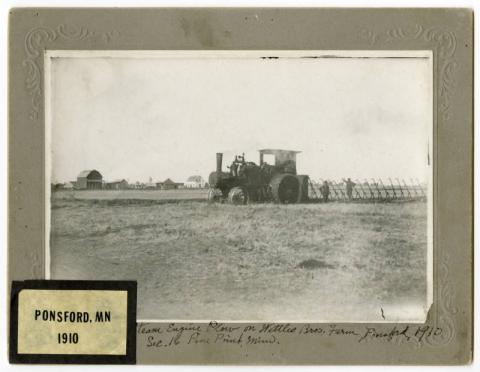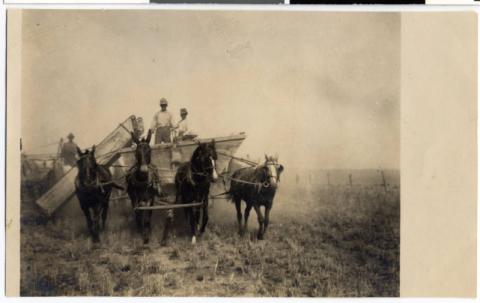Primary Source Set
by Erica Younglove, Reference Librarian, Jefferson-Madison Regional Library (Charlottesville, Virginia)
Agriculture Business and Industry
Mechanization of farm equipment in Minnesota began in the mid-19th century, but took almost a century to fully expand throughout the state. Mechanization freed workers up for urban jobs and increased both profits and productivity of farms by allowing farmers to work more land more efficiently with fewer workers.
The first steps towards mechanization were to change from human powered farm activities to those driven by horses and other animals. This started to happen with the invention of horse-drawn plows, binders, and harvesters. The Civil War led to increased demands on farmers in Minnesota, which drove a desire for the increased efficiency that mechanization provides. In 1862 Congress established both the United States Department of Agriculture (USDA) and passed the first of several Homestead Acts. The Homestead Acts of 1862 and 1866 opened up more than 270 million acres of public land for farming and settlement.
By the early 1900s, steam powered equipment and tractors were made widely available which led to ever greater efficiency in farming. The developments in mechanization enabled agriculture to evolve from smaller, less financially viable farms to a larger, for-profit business model. It also allowed for greater diversification of crops which helped protect farms from crop failures or poor markets. The first three decades of the 20th century ushered in the "Golden Age" of agriculture in Minnesota and led to full mechanization of farms. Mechanization only continued to grow throughout the 20th century allowing for the rise of commercial farming. These corporations were able to farm on large scales, undercutting the profits of individual farmers, and by the end of the century driving many of them out of business altogether.
Discussion Questions & Activities
- How did mechanization change agriculture in Minnesota?
- What do you think the advantages of horse drawn/steam powered equipment were?
- Do you think mechanization of agriculture was a good thing? Why or why not?
- What new skills do you think farmers had to learn when they had to begin acquiring and managing mechanical farm equipment?
- Many farmers had to add new technology slowly, while still supporting the animals and equipment they already had. Build a mock budget for pre-mechanization and after to see how the new costs affected farmers’ bottom lines. Take into account repairs, new farm structures for the equipment, but also larger farm acreage and higher crop yields.
- New technology would’ve required a lot of practice hours or training time to learn. How do you think farmers learned to use the new equipment? Where do you think they went to do so? Create a training program for farmers to prepare them for operating their new equipment. How long is the program? Is it in person?
- You are responsible for keeping far-flung farmers informed of new equipment, prices, and other farming tips. Before the days of the internet, this meant a mailed newsletter or brochure. Design a newsletter or brochure to send to farmers. What information would you include? How would you find out which farmers to send it to?
- Imagine you’ve just added new equipment to your farm. Write a journal entry or letter to friend about why you decided to add the new equipment, what changes you made, how much they cost, and how they are helping/changing your farm.
eLibrary Minnesota Resources (for Minnesota residents)
"Agricultural achievements." Machine Design, vol. 79, no. 8, 26 Apr. 2007, pp. 135+. Gale In Context: High School. Accessed 10 Oct. 2025.
"Agricultural Equipment Industry." Gale Encyclopedia of U.S. Economic History, edited by Thomas Riggs, 2nd ed., vol. 1, Gale, 2015, pp. 21-25. Gale In Context: High School. Accessed 10 Oct. 2025.
“Agricultural Machinery.” Funk & Wagnalls New World Encyclopedia, June 2023, p. 1. EBSCOhost. Accessed 10 Oct. 2025.
"Combine." Britannica School, Encyclopædia Britannica, 26 Nov. 2014. Accessed 11 Jun. 2018.
"Farm machinery." Britannica School, Encyclopædia Britannica, 30 Jul. 2021. Accessed 10 Oct. 2025.
Nall, Garry L. "American Agriculture: A Brief History." American Scientist, vol. 83, no. 6, 1995, p. 580+. Research in Context, Accessed 12 May 2018.
"Origins of agriculture." Britannica School, Encyclopædia Britannica, 10 Mar. 2017. Accessed 11 Jun. 2018.
"Tractor." Britannica School, Encyclopædia Britannica, 6 Feb. 2015. Accessed 11 Jun. 2018.
Additional Resources for Research
Blegen, Theodore C. Minnesota. University of Minnesota Press, 1975.
Kolnick, Jeff. "Land, Labor, the Market, and Politics." MNopedia, Minnesota Historical Society. http://www.mnopedia.org/land-labor-market-and-politics (accessed June 14, 2018).
"USDA - National Agricultural Statistics Service - Publications - Trends In U.S. Agriculture - Mechanization". Nass.Usda.Gov, 2018. Accessed 14 June 2018.
Published onLast Updated on














